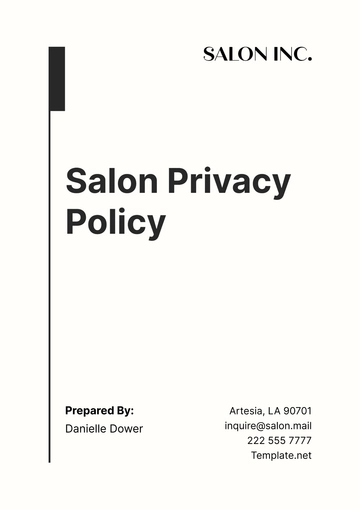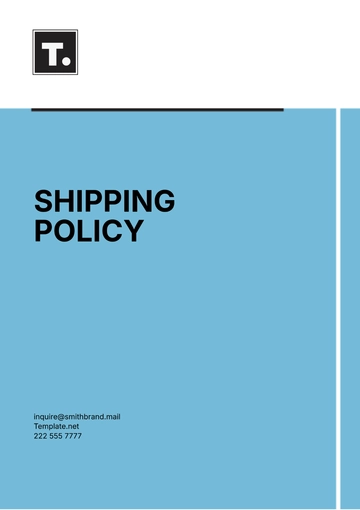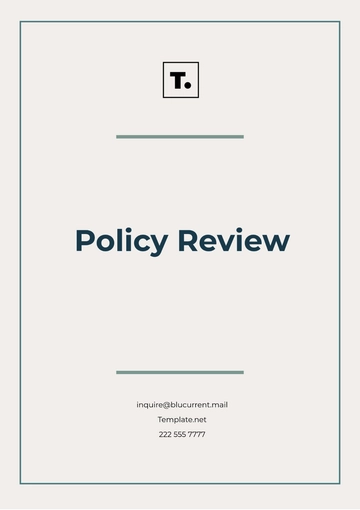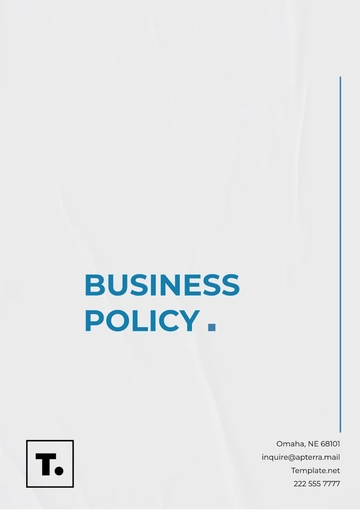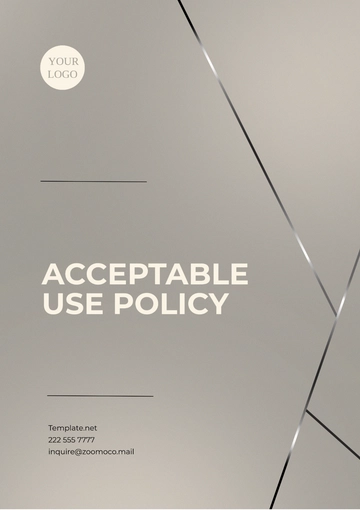Free Sales Policy & Procedure for Deal Renegotiations

1. Introduction
Welcome to [Your Company Name]'s authoritative Sales Policy & Procedure document, specifically tailored to address the complexities of Deal Renegotiations. In the dynamic landscape of modern business, contractual agreements occasionally need revisiting to adapt to new realities. Whether triggered by shifting market conditions, internal business realignments, or the evolving needs of our valued customers, renegotiations are sometimes an essential step in the lifecycle of a business relationship. This document is engineered to be a definitive guide, laying out the framework, rules, and best practices to navigate these intricate proceedings. By adhering to the guidelines and processes herein, [Your Company Name] aims to facilitate renegotiations that are not only seamless but also advantageous for all involved parties.
2. Scope and Purpose
The scope of this Sales Policy & Procedure document for Deal Renegotiations is all-encompassing, targeting every tier of our sales department. This includes but is not limited to sales representatives, account managers, sales executives, and anyone else directly involved in customer interactions, deal negotiations, and the finalization of contracts. The document is not merely a set of rules but serves a dual purpose. Firstly, it offers a well-defined, structured approach to renegotiating deals, setting the boundaries and processes that should be followed. Secondly, the policy is designed to balance our business objectives and the need to sustain a high level of customer satisfaction. It aims to equip our sales personnel with the tools and guidelines necessary to conduct renegotiations in a way that upholds the integrity of our business while also meeting or exceeding customer expectations. This comprehensive approach ensures that the renegotiation process aligns with our long-term strategic goals and ethical commitments.
3. Eligibility for Renegotiation
The eligibility for entering into renegotiations is determined by a set of specific criteria aimed at safeguarding the interests of both the customer and [Your Company Name]. Below are the criteria and their detailed descriptions:
Criteria | Description |
|---|---|
Contract Duration | Renegotiations can be initiated only for contracts with at least six months remaining in their term. This time frame ensures that both parties have adequate room to assess, negotiate, and implement new terms methodically, thereby preserving the quality of the deal. |
Market Fluctuations | Eligibility for renegotiation is activated by significant market shifts affecting pricing or contract terms. Qualifying conditions include economic downturns, commodity price variations, or notable industry trends. These market changes must be both verifiable and substantial enough to justify a contract review. |
Customer Request | A formal request for renegotiation from the customer constitutes eligibility. The request needs to be documented and include a compelling rationale—be it financial hardship, altered needs, or dissatisfaction with current service levels—to instigate the renegotiation process. |
Internal Changes | Substantial changes within [Your Company Name], such as in cost structure or capabilities, may warrant renegotiations. Such changes can involve material costs, labor, technology enhancements, or a pivot in strategic focus and must directly influence the contract's deliverables, costs, or timelines. |
4. Procedure Steps
Renegotiating a deal is a multi-step process that requires attention to detail, careful planning, and collaboration between various departments and stakeholders. Below is a detailed breakdown of each step involved in the renegotiation procedure, aimed to provide a structured approach to achieving favorable outcomes.
Initial Assessment. The first step is a thorough review of the existing contract. Examine the clauses, terms, and conditions to assess whether renegotiation is necessary and feasible. This may involve analyzing market conditions, customer performance metrics, and the internal capacities of [Your Company Name].
Customer Notification. Once it has been established that renegotiation is warranted, the next step is to inform the customer. The communication should be formal and provide a clear timeline for the renegotiation process. The objective is to foster transparency and give the customer ample time to prepare.
Internal Approval. Before proceeding with the renegotiation, it's imperative to obtain the necessary internal approvals. This usually involves consultation and approval from the Sales Manager and the Legal Department. Make sure that the proposed changes align with both sales objectives and legal requirements.
Renegotiation Meeting. This is the cornerstone of the renegotiation process. A formal meeting should be scheduled, involving key stakeholders from both parties. The agenda should be well-defined, aiming to address all points of contention and areas for improvement. This is the stage where both parties negotiate to reach a consensus.
Agreement Finalization. Based on the outcomes of the renegotiation meeting, the existing contract should be amended or a new one drafted. All changes should be clearly documented, with both parties agreeing to the revised terms and conditions.
Contract Sign-off. Once the new terms are finalized, the contract must be formally signed off by both parties. This often involves a secondary review by the legal department to ensure compliance with all regulations and internal policies.
Implementation. The final step involves practically implementing the new or amended terms and conditions. This could range from updating billing cycles to revising service delivery schedules. It's essential to monitor the transition to ensure that it is smooth and aligns with the newly agreed-upon terms.
By following these procedure steps in a structured manner, [Your Company Name] aims to facilitate effective and mutually beneficial deal renegotiations.
5. Roles and Responsibilities
In the intricate process of contract renegotiation, clearly defined roles and responsibilities are paramount to ensuring a smooth, efficient, and legally compliant procedure. The following table delineates the roles involved and outlines their specific responsibilities, providing a framework for accountability and collaboration.
Role | Responsibilities | Details |
|---|---|---|
Sales Manager | Approve renegotiation process, oversee proceedings | The Sales Manager holds the ultimate authority to initiate the renegotiation process and must oversee its entire course. They are responsible for setting the agenda, approving the members involved in negotiations, and making the final call on agreement terms. |
Account Manager | Liaison with the customer, gather data for negotiation | The Account Manager is the primary point of contact with the customer. They are tasked with gathering all pertinent data affecting the renegotiation, such as customer feedback, performance metrics, and market trends. They should also communicate timelines and updates to the customer. |
Legal Department | Review and amend contract terms | The Legal Department plays a critical role in reviewing the existing contract and any proposed changes to ensure they are legally sound. They are also responsible for drafting the amended contract, if necessary, and ensuring it complies with legal requirements and company policies. |
6. Documentation and Record-Keeping
A well-organized system of documentation and record-keeping is an integral part of any renegotiation process. Meticulous records not only offer a clear history of proceedings but also serve as a valuable reference for future negotiations and ensure compliance with legal and internal company requirements.
Specifics to be Documented Include:
Correspondence with the Customer: Every communication with the customer, whether it's email, voice calls, or face-to-face meetings, should be documented. This includes initial notifications, queries, responses, and any confirmations.
Meeting Minutes: Minutes of all meetings related to the renegotiation should be taken and archived. These should detail what was discussed, the decisions made, and any commitments or deadlines set during the meetings.
Changes in Terms and Conditions: All changes to the original contract terms, whether minor or significant, should be explicitly documented. This record should also include the rationale behind the changes and evidence supporting them, such as market data or customer feedback.
Signed Amended Contract: Once all parties agree on the new terms, the amended contract must be signed by authorized representatives. A digital or hard copy should be securely stored, and a copy should be provided to the customer.
Date for Record-Keeping: All documents related to the renegotiation process must be stored securely and remain accessible for review until December 31, 2050. This aligns with internal policies for record retention and ensures we remain compliant with legal and regulatory mandates.
By adhering to this stringent documentation and record-keeping guidelines, [Your Company Name] aims to maintain transparency, ensure accountability, and minimize risks during the contract renegotiation process.
7. Revision and Review
The landscape of business and contract management is ever-changing, affected by shifts in market conditions, regulatory updates, and internal strategic objectives. In recognition of this dynamic environment, this Sales Policy and procedure for Deal Renegotiations will undergo regular reviews to ensure it remains both relevant and effective. The policy is set to be reviewed annually to assess its efficacy, identify areas for improvement, and make any required updates.
Additionally, ad hoc reviews may be conducted when there is a significant change that could directly impact the renegotiation procedures. Such triggers could include new legal requirements, substantial shifts in market conditions, or major internal changes like reorganization or technological upgrades. This flexible approach to policy review ensures that [Your Company Name] stays responsive and agile, effectively managing renegotiations in a way that benefits both the company and our valued clients.
8. Enforcement and Compliance
Adherence to this Sales Policy and procedure for Deal Renegotiations is not merely a guideline but a requirement for maintaining the integrity, reputation, and effectiveness of [Your Company Name]'s business operations. Failure to comply with the policy can have serious ramifications, including contractual disputes, legal issues, and damage to customer relationships. For these reasons, non-compliance will be subject to a structured disciplinary process. This could range from formal warnings and mandatory training to more severe actions like demotion or, in extreme cases, termination of employment.
To ensure a thorough understanding and compliance with this policy, all relevant staff will be provided with access to the policy document and will undergo periodic training. This will be coupled with regular internal audits to verify adherence to the policy, supported by a reporting mechanism that allows for confidential reporting of any policy violations. By having stringent enforcement and compliance measures in place, [Your Company Name] aims to consistently conduct deal renegotiations that are fair, transparent, and beneficial for all parties involved.
9. Case Studies
To showcase the effectiveness and applicability of this Sales Policy and procedure for Deal Renegotiations, we have compiled case studies from past experiences where the policy was successfully implemented.
Company | Objective | Outcome | Date |
|---|---|---|---|
[Company X] | Extend contract duration | Successful extension by 12 months | [Month, Day, Year] |
[Company Y] | Amend pricing structure | Achieved a 10% reduction in costs for the client | [Month, Day, Year] |
Case Study: [Company X]
Objective: Extend contract duration
Outcome: Successfully extended the contract by an additional 12 months
Additional Details: The renegotiation process involved multiple rounds of discussions, beginning with an internal assessment followed by notifying the customer. Our sales manager and account manager actively participated in these discussions, and the final agreement was reviewed by our Legal Department. The process concluded with both parties signing the extended contract, achieving a win-win situation.
Case Study: [Company Y]
Objective: Amend pricing structure
Outcome: Achieved a 10% reduction in costs for the client
Additional Details: The renegotiation was initiated due to significant market fluctuations affecting both parties. Internal approvals were sought, and a formal renegotiation meeting was held. The successful amendment led to a 10% cost reduction without compromising the quality or delivery timelines. A legal review ensured the amended terms were fair and compliant with all applicable laws.
These case studies serve as tangible evidence of the efficiency and effectiveness of our policy when it comes to deal renegotiations. They also provide useful insights into how the policy can be implemented in various situations, ensuring the renegotiation process is carried out systematically and benefits all parties involved.
- 100% Customizable, free editor
- Access 1 Million+ Templates, photo’s & graphics
- Download or share as a template
- Click and replace photos, graphics, text, backgrounds
- Resize, crop, AI write & more
- Access advanced editor
Sail through deal renegotiations with confidence using Template.net's Sales Policy & Procedure for Deal Renegotiations Template. It is customizable and editable using our Ai Editor Tool which offers you a roadmap for structuring, negotiating, and finalizing revamped agreements. The perfect resource for sales and legal professionals who want to ensure a win-win outcome in every renegotiation.
You may also like
- HR Policy
- Restaurant Policy
- Company Policy
- Accounting Policies and Procedures
- Website Policy
- Privacy Policy
- Safety Policy
- School Policy
- IT and Software Policy
- Law Firm Policy
- Construction Policy
- Interior Design Policy
- Travel Agency Policy
- Education Academic Policy
- Security Policy
- Real Estate Policy
- Expense Policy
- Software Policy







